How Do Chinchilla's Sleeping Habits Vary by Species?
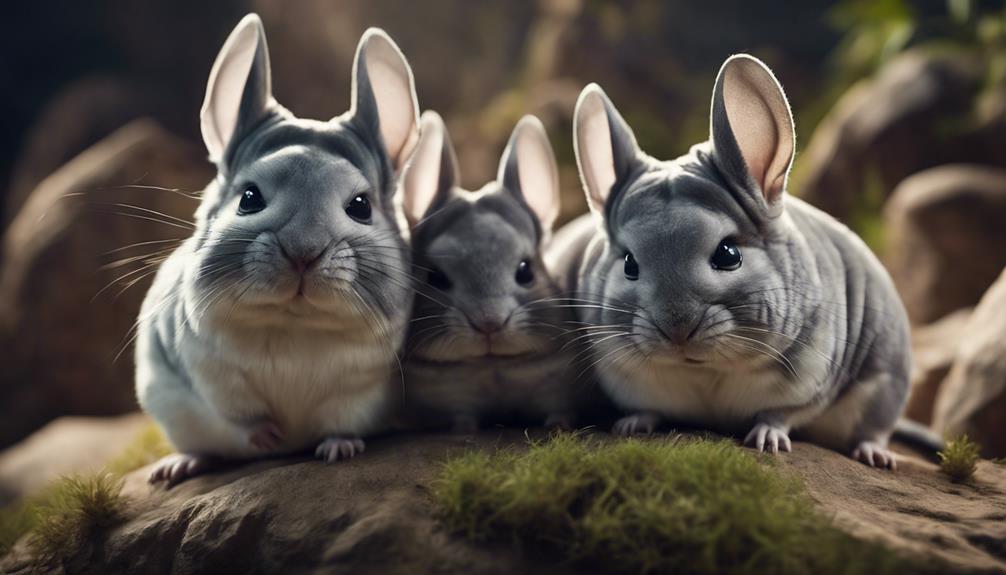
Chinchillas are naturally crepuscular animals, meaning they are most active during dawn and dusk. However, there are variations in sleeping patterns among different chinchilla species. For example, short-tailed chinchillas tend to sleep for longer periods during the day compared to long-tailed chinchillas. These variations in sleep habits are believed to be influenced by factors such as habitat, diet, and predator threats.
Understanding the different sleeping patterns of chinchilla species can help owners provide appropriate care and an environment that supports their natural behaviors. By observing and respecting their natural rest patterns, chinchillas can lead healthier and happier lives in captivity.
Short-tailed Chinchilla
How does the short-tailed Chinchilla differ in its sleeping habits compared to other species? Short-tailed Chinchillas, native to the Andes Mountains, exhibit unique nesting habits and social interactions during their rest periods. These small rodents create elaborate nests in the wild, using grass, leaves, and twigs to construct cozy sleeping areas where they can retreat for hours at a time. Unlike some other chinchilla species, short-tailed Chinchillas are more social creatures, often preferring to sleep in groups for added warmth and protection.
In terms of grooming routines and communication methods, short-tailed Chinchillas are meticulous groomers, spending a significant amount of time each day cleaning their fur using their dexterous paws and teeth. This grooming not only helps them maintain a healthy coat but also serves as a form of social bonding and communication among group members. Through grooming, chinchillas establish hierarchies, strengthen social bonds, and convey emotions such as affection or dominance.
Long-tailed Chinchilla
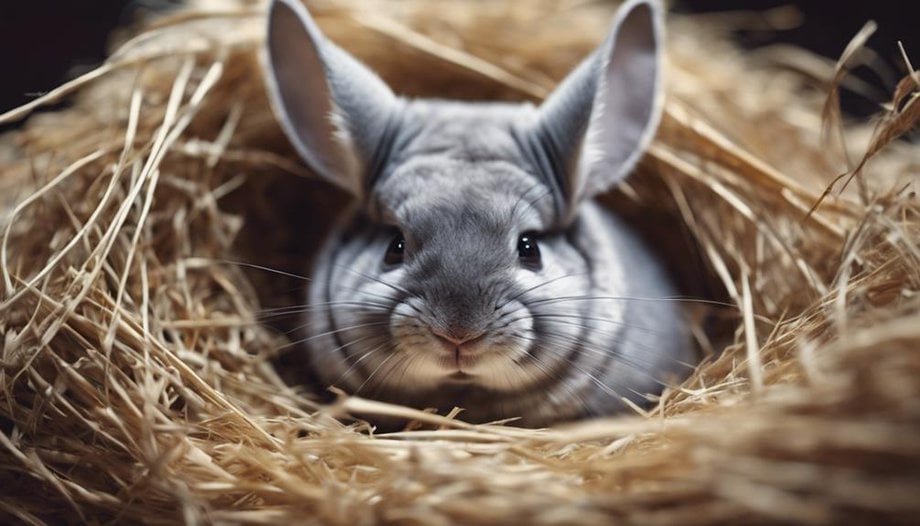
The Long-tailed Chinchilla, found in the mountainous regions of South America, showcases distinct sleeping patterns and behaviors that set it apart from other chinchilla species. Long-tailed chinchillas are crepuscular, meaning they're most active during dawn and dusk. This activity pattern influences their sleeping preferences, with long-tailed chinchillas often taking short naps throughout the day to conserve energy for their peak activity times.
In terms of sleep cycles, long-tailed chinchillas typically engage in polyphasic sleep, which involves multiple periods of rest throughout a 24-hour period. They're known to have quick sleep onset, easily drifting off to sleep when they feel safe and comfortable in their environment. These chinchillas are light sleepers and are sensitive to disturbances, which is an adaptation for survival in the wild. Their sleeping habits reflect their natural habitat, where they need to remain alert to potential predators even during their resting periods.
Understanding the sleeping preferences and sleep cycles of long-tailed chinchillas is crucial for providing proper care and ensuring their well-being in captivity.
Coastal Chinchilla
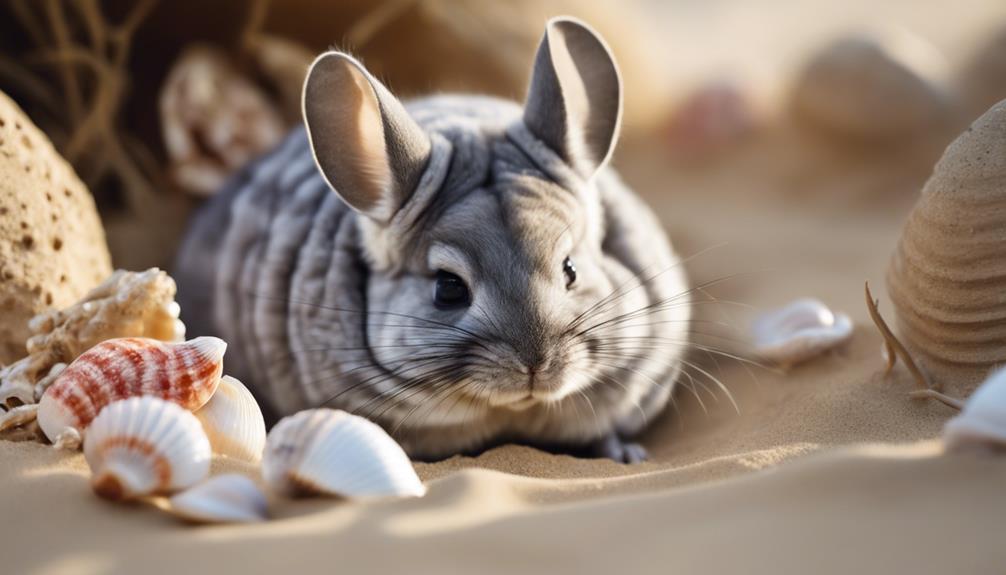
In coastal regions, the Coastal Chinchilla exhibits distinctive sleeping patterns influenced by its unique habitat and environmental factors. These chinchillas, found along the coastlines, have adapted their behavior to suit the specific conditions of their environment. One notable aspect is their preference for sleeping during the day, unlike other chinchilla species. This behavioral difference is thought to be a response to the presence of predators that are more active at night along the coast.
| Sleeping Patterns | Environmental Factors | Behavioral Differences |
|---|---|---|
| Daytime sleepers | Coastal climate | Increased vigilance |
| Shorter sleep cycles | Ocean proximity | Enhanced burrowing behavior |
| Group sleepers | Sand dune habitats | Social interactions |
The environmental factors of the coastal regions play a significant role in shaping the behavior of these chinchillas. The proximity to the ocean might influence their shorter sleep cycles, possibly due to the sound of the waves or the cooler temperatures. Additionally, the presence of sand dune habitats encourages more group sleeping among coastal chinchilla populations, fostering social interactions and cooperative behaviors.
Bolivian Chinchilla
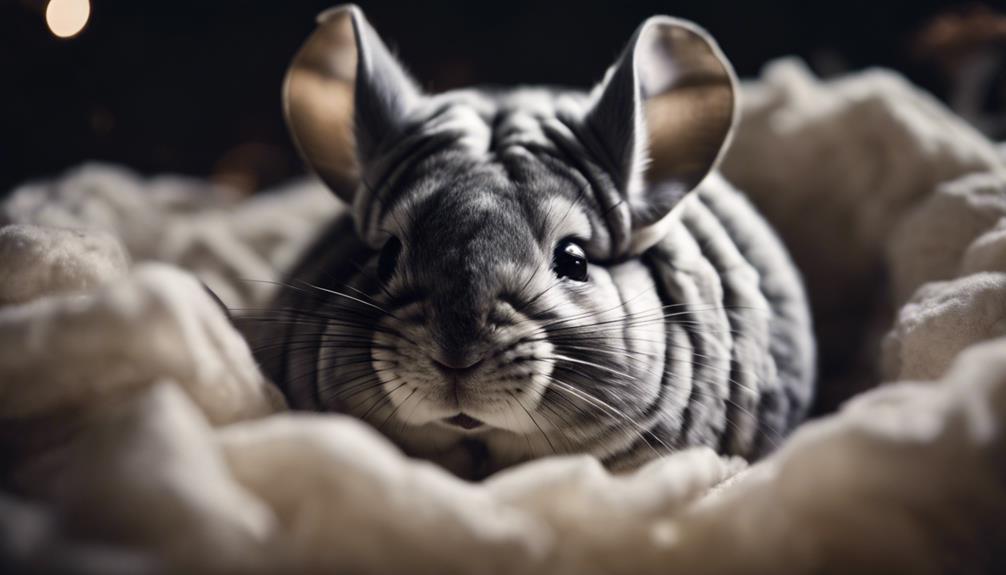
The Bolivian Chinchilla, native to the Andes Mountains in Bolivia, thrives in high-altitude regions with rocky terrains and sparse vegetation.
These chinchillas are known for their nocturnal behavior, being most active during the night and resting during the day in burrows or rock crevices.
Their diet mainly consists of grasses, seeds, and small insects found in their mountainous habitat.
Bolivian Chinchilla Habitat
Bolivian Chinchillas thrive in high-altitude regions with sparse vegetation. Their natural habitat consists of mountainous terrain, where they've adapted to survive in these challenging conditions. Due to the high altitude, Bolivian chinchilla behavior includes unique characteristics that help them cope with the limited oxygen and harsh environment.
These chinchillas have developed efficient respiratory systems to extract oxygen effectively from the thin air found at these elevations. Their thick fur provides insulation against the cold temperatures commonly experienced in mountainous regions. The sparse vegetation in their habitat has led Bolivian Chinchillas to have specialized diets, primarily consisting of grasses, shrubs, and seeds.
Understanding the specific requirements of their high-altitude habitat is crucial for the conservation and well-being of Bolivian Chinchillas.
Bolivian Chinchilla Behavior
Thriving in high-altitude environments with sparse vegetation, the Bolivian Chinchilla exhibits a range of distinctive behaviors shaped by its mountainous habitat.
- Nocturnal Habits: Bolivian Chinchillas are primarily nocturnal creatures, displaying heightened activity levels during the night while being more restful during the day.
- Social Interactions: These chinchillas engage in complex social interactions within their groups, communicating through vocalizations, scent markings, and body language to establish hierarchy and maintain cohesion.
- Nesting Behaviors: Bolivian Chinchillas demonstrate meticulous nesting behaviors, creating cozy burrows lined with soft materials like grass and fur to provide warmth and comfort.
- Grooming Rituals: Grooming plays a crucial role in their social structure, aiding in bonding, hygiene maintenance, and the removal of parasites from their dense fur coats.
Bolivian Chinchilla Diet
In their natural habitat, Bolivian Chinchillas showcase a diverse diet consisting of various plant materials and occasional insects. These small mammals are primarily herbivores, feeding on grasses, seeds, and leaves found in the Andes Mountains of Bolivia. Their diet is rich in fiber, which aids in digestion and overall gut health.
Bolivian Chinchillas also consume small amounts of insects to supplement their protein intake. This varied diet provides essential nutrients for their survival and contributes to their overall well-being. Understanding the Bolivian Chinchilla diet is crucial for their care in captivity, ensuring their nutritional needs are met.
A balanced diet plays a significant role in their health, energy levels, and even influences their sleeping patterns.
Chilean Chinchilla

Widely known for their nocturnal behavior, the Chilean Chinchillas are small rodents native to the Andes mountains of South America. These fascinating creatures have unique sleep patterns and specific habitat preferences that contribute to their survival in the wild.
- Sleep Patterns:
- Chilean chinchillas are primarily crepuscular, meaning they're most active during dawn and dusk.
- They tend to rest during the day in burrows or rocky crevices to avoid predators.
- Their sleep is characterized by short, light naps interspersed with periods of alertness to watch for potential dangers.
- These animals have adapted to sleep in short bursts rather than long continuous periods to remain vigilant in their natural environment.
Understanding the sleep patterns and habitat preferences of Chilean Chinchillas provides valuable insight into their behavior and aids in creating suitable captive environments for these unique creatures.
Royal Chinchilla
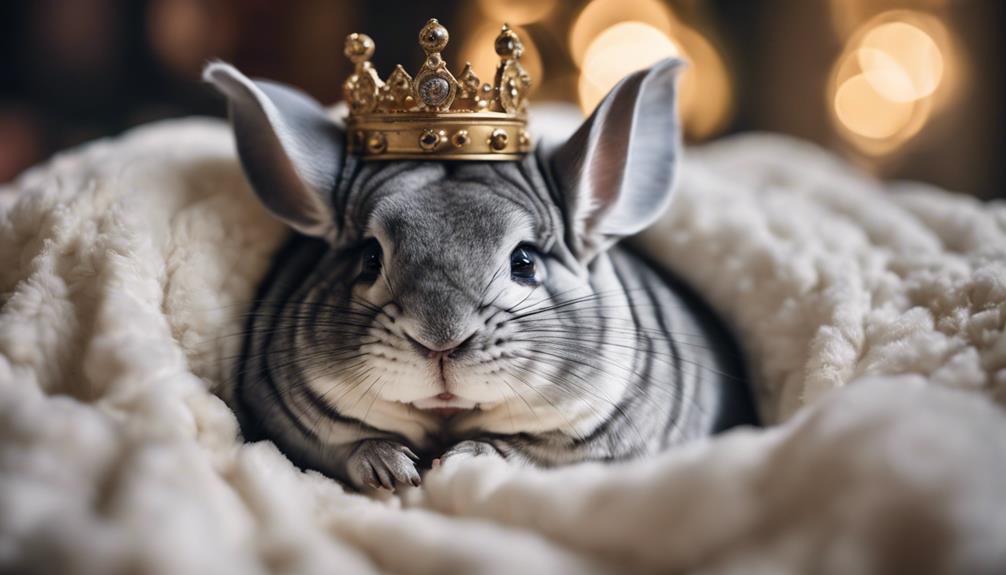
The Royal Chinchilla, a distinct species known for its luxurious fur and regal demeanor, exhibits intriguing behaviors that set it apart from other chinchilla species.
Researchers have noted that Royal Chinchillas display unique sleeping patterns, often preferring to nap in elevated areas or secluded corners of their habitat.
Understanding these behaviors can provide valuable insights into the evolutionary adaptations of these majestic creatures.
Royal Chinchilla Behaviors
Royal Chinchillas exhibit distinct behaviors in their natural habitat, showcasing unique social interactions and communication methods within their group.
- Social Hierarchy: Within a royal chinchilla group, there's a clear social structure with dominant and submissive individuals, often determined through subtle behaviors like grooming exchanges and body language cues.
- Vocalizations: Royal Chinchillas use a variety of vocalizations to communicate with one another, including chirps, purrs, and squeaks, which play a crucial role in maintaining group cohesion and signaling danger.
- Scent Marking: These chinchillas engage in scent-marking behaviors to define territory boundaries and communicate reproductive status, using specialized scent glands located on their bodies.
- Playful Interactions: Royal Chinchillas engage in playful behaviors within their groups, such as chasing one another, hopping around, and engaging in mock fights, which help strengthen social bonds and relieve stress.
Unique Sleeping Patterns
Among chinchilla species, the unique sleeping patterns of the Royal Chinchilla stand out for their distinct characteristics and adaptations to their environment. Royal Chinchillas are nocturnal animals, meaning they are most active during the night, displaying behaviors like running on their exercise wheels or exploring their surroundings. During the day, they often engage in short periods of daytime napping to recharge their energy levels. In terms of social behavior during sleep, Royal Chinchillas exhibit a preference for social sleeping, where they sleep in close proximity to other chinchillas within the same group. However, they also indulge in solitary slumber, occasionally seeking out alone time for rest and relaxation.
| Sleeping Pattern | Description |
|---|---|
| Nocturnal Activity | Active during the night, engaging in various behaviors. |
| Daytime Napping | Short periods of napping during the day to rest and rejuvenate. |
| Social Sleeping | Preference for sleeping near other chinchillas in their group. |
| Solitary Slumber | Occasional need for alone time during sleep for relaxation. |
Peruvian Chinchilla
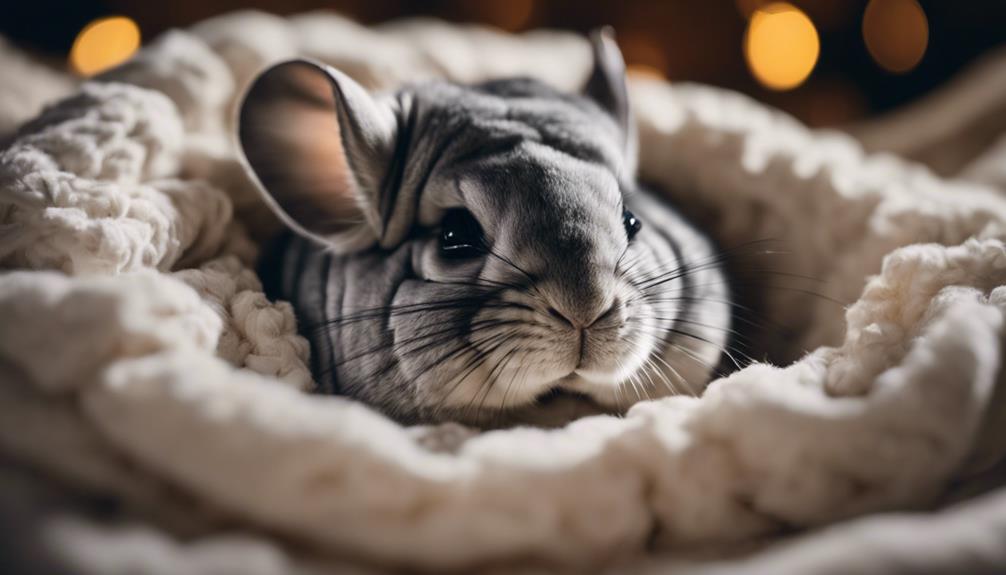
Peruvian Chinchillas display distinct sleeping patterns compared to other chinchilla species, characterized by their specific breeding habits and fur care needs. Here are some key observations regarding the sleeping habits of Peruvian Chinchillas:
- Nocturnal Behavior: Peruvian Chinchillas, like other chinchilla species, are primarily nocturnal, meaning they're most active during the night and rest during the day.
- Burrowing Tendencies: These chinchillas have a natural inclination to burrow, creating cozy nests in which they sleep and seek shelter. This behavior is essential for their sense of security and comfort.
- Social Sleeping: Peruvian Chinchillas often prefer to sleep in pairs or groups, mirroring their social nature in the wild. This communal sleeping behavior helps them feel safe and connected to their companions.
- Temperature Sensitivity: Due to their dense fur and origins in the Andes Mountains, Peruvian Chinchillas are more sensitive to high temperatures. They may adjust their sleeping patterns to avoid heat, seeking cooler spots in their habitat for rest.
Frequently Asked Questions
Can Chinchillas From Different Species Live Together Peacefully?
Chinchillas from different species can coexist peacefully if introduced gradually, respecting their natural social behavior. However, interspecies interaction may vary, and aggression levels should be monitored to ensure species compatibility and harmonious living arrangements.
Do Chinchilla's Sleeping Habits Change as They Age?
As chinchillas age, their sleep patterns undergo changes. Young chinchillas have shorter sleep cycles, while older ones tend to sleep longer and more deeply. This shift in sleep behavior is a natural part of their maturation process.
How Do Chinchillas in the Wild Differ in Their Sleeping Patterns Compared to Domestic Chinchillas?
Wild chinchillas exhibit more natural sleeping behaviors, following their instincts to rest during the day and be active at night. In contrast, domestic chinchillas may adapt to human schedules, leading to variations in their sleep patterns.
Are There Any Specific Environmental Factors That Can Affect a Chinchilla's Sleep?
Environmental factors such as light exposure, temperature, noise levels, and diet can impact a chinchilla's sleep. Their natural habitat influences these variables, affecting their rest patterns and overall well-being, emphasizing the importance of mimicking natural conditions in captivity.
Do Chinchillas From Different Species Have Different Dream Patterns?
Dream research in chinchillas reveals behavioral differences across species. Variations in sleep cycle and brain activity suggest unique dream patterns. Understanding these distinctions could shed light on the intricate world of chinchilla sleep habits.










